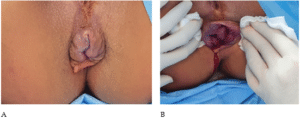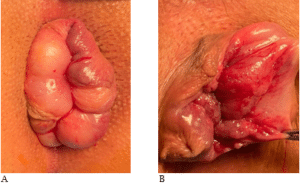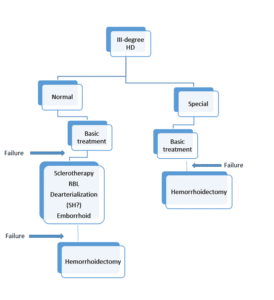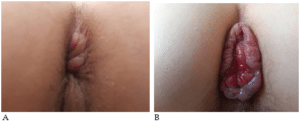Sayali Valiyeva1, Paolo Cerri2, Simone Cicconi2, Antonio Pisciaroli2, Alfredo Torretta2, Renato Pietroletti1*
1Surgical Coloproctology, University of L’Aquila, Department of Clinical Medicine and Biotechnology, Hospital Val Vibrata, Sant’Omero (TE), Italy
2Hospital Val Vibrata, Sant’Omero (TE), Italy
*Correspondence author: Renato Pietroletti, Surgical Coloproctology, University of L’Aquila, Department of Clinical Medicine and Biotechnology, Hospital Val Vibrata, Sant’Omero (TE), Italy; Email: [email protected]
Published On: 31-03-2023
Copyright© 2023 by Pietroletti R, et al. All rights reserved. This is an open access article distributed under the terms of the Creative Commons Attribution License, which permits unrestricted use, distribution and reproduction in any medium, provided the original author and source are credited.
Abstract
Background: Haemorrhoidal Disease (HD) is common and impacts negatively on quality of life with high socio-economic costs. Despite international guidelines aimed to indicate appropriate care in HD, treatment of III-degree HD remains controversial due to the wide range of ambulatory or surgical procedures available.
We aimed to analyse treatment options for III-degree HD focusing on special cases characterized by large volume and/or circumferential presentation of intermittent prolapse or recurrence after conservative treatments.
Methods: In the period January 2017- December 2018 out of 152 patients treated by excisional haemorrhoidectomy, we collected a case series of 29 patients affected by III-degree symptomatic HD. They showed a very large, single prolapse or circumferential one or failure of previous conservative treatments.
Results: 14 (48.2%) patients (median age 45 yrs.) of our series were recurrence of HD following Rubber Band Ligation (RBL) (5pts), Dearterialization (DEART) (5pts), Stapled Haemorrhoidopexy (SH) (4pts). Mean operative time was 35 min. Postoperative severe pain (6.8%) and urinary retention (17.2%) were the main postoperative complications which did not affect the length of stay. All patients showed a good outcome without any complication at follow-up.
Conclusion: III-degree HD shows the highest variability in anatomical presentation, and proposed treatment. Thus, the choice of a personalized approach must rely upon objective evaluation of volume of prolapse. Intermittent prolapse, if very large or circumferential, associated or not to large external haemorrhoids, makes a special condition III degree HD, suggesting surgical excision, avoiding conservative approaches.
Keywords: III Degree; Haemorrhoidal Disease; Circumferential Prolapse; Large Prolapse; Haemorrhoidectomy
Introduction
The prevalence of Haemorrhoidal Disease (HD) in the general population is estimated to be 4.4%. In both sexes, a peak in prevalence is observed between 45 and 65 yrs. of age, with a subsequent decrease after age 65 yrs. The development of HD before age of 20 yrs. is unusual [1,2].
Constipation, a low fibre diet, a high Body Mass Index, pregnancy, and a sedentary lifestyle are assumed as risk factors of HD; however, evidence regarding these predisposing factors are controversial [3]. Conservative and surgical treatment of HD are well standardized and focused on the severity (grading) of disease as reported in different guidelines [4-6].
The III-degree HD is suitable for a wide range of treatment options, ranging from less invasive methods to conventional excisional surgery. However, if the intermittent prolapse occurs in very large piles, or is circumferential and/or accompanied by perianal fibrosis/oedema, Rubber Band Ligation (RBL), Sclerotherapy (SCL), Dearterialization (DEART) or Stapled Hemorrohidopexy (SH), may be contra-indicated and burdened by short-term complications or failure [4,6]. Therefore, despite the definition of III-degree HD as intermittent prolapse, such situation encompassing very different anatomical pictures can be considered as a “III-degree special”. This can represent a challenge in the choice of a tailored treatment.
The aim of this article is to analyse treatment options for III-degree HD focusing on those particular cases characterized by large volume of prolapse, circumferential presentation or recurrence after conservative treatments. We present a case series of III-degree HD showing features identifying a “III-degree special HD”.
Patient Case Series
Patients collected in the present case series were observed during the period January 2017-December 2018, in a high volume, referral, surgical coloproctology unit mainly by a senior consultant. In that time range 110 patients affected by IV-degree HD were selected for surgery whereas 168 patients affected by III-degree HD were treated successfully by conservative measures (high fibres diet, flavonoids, and sclerotherapy or RBL) in 63.7% of the cases. 61 patients instead needed a tailored approach with a dearterialization/hemorrhoidopexy procedure in 19 cases (31.1%) and a Milligan Morgan operation in 42 cases (68.9%).
In total 152 patients underwent Milligan-Morgan haemorrhoidectomy, 110 affected by IV-degree HD (72.4%), 13 cases whose grading was doubtful (III vs. IV) and 29 patients presented in this case series. They were all affected by III-degree, symptomatic HD showing very large prolapse and/or circumferential presentation or failure of previous conservative treatments. There were 19 males and 10 females with a median age of 51 years (range 38-67).
24 patients reported constipation with less than three bowel movements a week whereas 4 of them complained frequent episodes of diarrhoea. All patients reported prolonged time on the toilet, ranging from 10 to 35 minutes. 5 males and 3 female patients were devoted to intense physical training, for fitness purposes. Presentation of HD is depicted in Table 1. Fourteen patients (48.2%) had a previous treatment performed; 5 RBL, 5 DEART and 4 SH.
|
S. No. |
Patients Age/Sex |
Large Prolapse |
Circumferential Prolapse |
Perianal Fibrosis/Oedema |
Relapse/Previous Treatment |
|
1. |
67/M |
+ |
+/SH |
||
|
2. |
55/M |
+ |
+/SH |
||
|
3. |
50/M |
+ |
+ |
||
|
4. |
55/F |
+ |
+ |
||
|
5. |
58/F |
+ |
|||
|
6. |
51/M |
+ |
+ |
+ |
|
|
7. |
58/M |
+ |
+ |
||
|
8. |
45/M |
+ |
+ |
+/ Dearterialization |
|
|
9. |
38/M |
+ |
+ |
+ |
+/RBL |
|
10. |
53/F |
+ |
+ |
+/RBL |
|
|
11. |
36/M |
+ |
+ |
||
|
12. |
58/M |
+ |
+ |
+/SH |
|
|
13. |
44/F |
+ |
+/SH |
||
|
14. |
49/M |
+ |
+ |
||
|
15. |
47/F |
+ |
|||
|
16. |
62/F |
+ |
|||
|
17. |
50/M |
+ |
+ |
+ |
|
|
18. |
60/M |
+ |
+ |
||
|
19. |
46/M |
+ |
+ |
+/Dearterialization |
|
|
20. |
50/M |
+ |
+ |
+ |
+/RBL |
|
21. |
44/F |
+ |
+ |
+/RBL |
|
|
22. |
48/M |
+ |
+ |
+ |
|
|
23. |
52/F |
+ |
+ |
+ |
+/RBL |
|
24. |
47/M |
+ |
+ |
+ |
+/ Dearterialization |
|
25. |
62/M |
+ |
+/ Dearterialization |
||
|
26. |
55/M |
+ |
+ |
+ |
|
|
27. |
52/F |
+ |
|||
|
28. |
47/F |
+ |
+ |
||
|
29. |
56/M |
+ |
+/ Dearterialization |
||
|
Total |
20 |
23 |
14 |
14 |
Table 1: Clinical features of patient series.
Preoperative preparation included enema, short-term antibiotic prophylaxis with metronidazole, 500 mg i.e. Haemorrhoidectomy was performed under spinal anaesthesia in lithotomy position. After exposure of the haemorrhoidal cushions, and adrenaline infiltration (dilution 1: 250.00), excision of the piles was by means of diathermy or radiofrequency. The wounds were partially closed with continuous sutures in polyglactin 2/0. Pain prophylaxis was instituted by i.v. infusion of Morphine and Ketorolac via elastomeric pump, discontinued at discharge. Patients stayed overnight and were discharged the morning after with prescription of bulking laxatives, pain prevention with oral Ketorolac (30 mg t.i.d.) and high fibre diet. Follow-up included 10-days, 1-month and 1-year controls.
Results
Out of 152 patients undergoing Milligan Morgan haemorrhoidectomy in the period of observation, 29 patients (19%) presented features of “special” III-degree HD. In 14 (48.2%) cases the presentation of HD was a recurrence after a previous treatment. The operation was conducted as a standard procedure, with a median operative time of 30 minutes (range 20-40). Postoperative severe pain (2 pts-6.8%) and urinary retention (5 pts-17.2%) were the main postoperative complications not affecting length of stay. No readmission for early or late bleeding, neither for intense pain were observed. At first follow-up, patients reported a median number of 2 daily bowel movements a day, starting from the second post-operative day. At 30 days follow up visit healing of perianal wounds was almost completed; rectal examination was performed with normal findings and no stenosis was detected. At one year follow up, data were available for twenty-six patients, all showing good general and local conditions. Three patients complained of occasional, bright red anal bleeding and persisting constipation. Intraoperative pictures of some of the most relevant cases are in Fig. 1,2.

Figure 1: 45 years old female patient with circumferential perianal fibrosis (A) and intermittent prolapse and bleeding (B). No previous outpatient/surgical treatment.

Figure 2: 38 years old male patient, with perianal oedema (A) and intermittent circumferential prolapse (B). No previous outpatient/surgical treatment.
Discussion
According to the most recent guidelines, symptomatic III-degree HD may encounter the widest range of treatments from pharmacological and diet advice to ambulatory procedure (SCL, RBL) or less invasive “surgical” methods (DEART, SH), up to conventional, excisional surgery [4,6-8]. Fig. 3 shows the wide range of treatment options in case of intermittent prolapsing HD (III-degree). On the other hand, the heterogeneity of case presentation explains the complexity in the choice of a tailored treatment.

Figure 3: Therapeutic range for III-degree HD. Basic treatment: pharmacological and diet advices.
The complexity in management of symptomatic III-degree HD may be related to inaccurate definition of Goligher’s intermittent prolapse [4]. III-degree HD encompasses mild, localized, or diffused intermittent prolapse, as well as very large, giant prolapsing piles up to circumferential prolapse. This clinical picture may be characterized by an almost normal anus at rest and a very large amount of anal prolapse at defecation or at physical efforts, albeit completely reducible with manual manipulation (Fig. 3). Therefore, the limits of the Goligher’s classification in indicating a tailored treatment are encountered mainly in the definition III-degree [6].

Figure 4: This picture is a special III-degree. A) Anus at rest everyday; B) After defecation.
For instance, in the survey conducted by Dekker L, et al., among the 95 participants of Dutch Workgroup Coloproctology on the use of the Goligher classification, the differentiation between II and III-degree HD appeared to be the hardest, as reflected by only fair agreement between respondents [8].
Different proposals have been made for a new, improved classification of HD. The PATE 2006 (Position, Acute, Tone, External) classification includes important parameters in assessing the severity of HD, such as numerical scores, symptom severity analysis and quality of life analyses [9,10]. The Single Pile Haemorrhoid Classification (SPHC) proposed by Elbetti, et. al., showed to be a feasible instrument for high grad both to describe and to compare patients affected by haemorrhoidal disease [11].
Recently the Rørvik score of HD has been introduced, considering the impact of symptoms severity on the quality of life and concluding that the association with Goligher’s anatomic classification was weak. This is in line with previous findings in which grade of prolapse and symptoms were poorly correlated [12]. Finally, there are new proposals for classifications of HD, as BPRST (bleeding, prolapse, reducibility, skin tags and thrombosis) waiting for validation before applicable in clinical practice [13].
These classifications are designed to improve the therapeutic indication by taking into consideration the symptoms related to the HD but the appropriate therapy is closely linked to the character of the prolapse in the case of III-degree [9-11,14].
It is noteworthy that 14 out 29 patients in our case series were recurrence of HD after less invasive procedures (5 RB, 5 DEART, 4 SH). RB is cheap and serious complications are rare, but recurrence is common, particularly when prolapse is abundant, thus requiring often further banding [15]. In their study, Lyer, et al., showed that RB with a median of two ligature had a 71% success rate and when four or more bands were placed, the authors noted a higher failure rate [16]. Van Tol RR, et al., described the superiority of RBL for II-degree HD and of excisional procedures for III-degree HD [17]. III-degree HD improves in 78-83.8% after RBL [18]. However, surgical procedures will be necessary for patients whose symptoms are not relieved with RB and those with circular prolapse [4].
The literature showed safety, efficacy and good tolerance of DEART for treatment of II/III-degree haemorrhoids but overall recurrence rate after such procedure ranges between 3 and 24% with re-treatment for recurrent symptoms, performed in 2.7-22% of patients [19].
SH, a surgical treatment suggested for third-degree HD, showed a higher incidence of recurrence compared to haemorrhoidectomy. The higher recurrence rate was confirmed by retrospective studies and systematic reviews [20,21]. Apart from a high recurrence rate, overall incidence of complication of SH ranged from 3.3%-81% with 5 mortalities documented. Early and late complications were defined individually with overall data suggesting that early complications ranged from 2.3%-58.9% and late complications ranged from 2.5%-80% [22,23]. In a recent survey of 32000 cases collected in specialized proctological centres, SH in III-degree HD decreased from 30-35% in the early 2000 to less than 5 % in 2007 [24]. In addition, recent systematic review concluded a lack of evidence for routine use of SH in clinical practice [25].
Conventional excisional haemorrhoidectomy has been associated with postoperative discomfort, sometimes necessitating admission to hospital and delayed return to normal activity, but recurrence is low [26].
In our experience, indications for surgical treatment in III-degree HD were the volume of the prolapse and the circumferential prolapse. Results showed in this patient series suffer of several limitations since it is retrospective, single centre and almost single surgeon, with no comparative group thus diminishing its scientific value. However, we contribute to the evidence of a debatable reliability in defining III-degree HD and suggest introducing a subgroup in this category; prolapse of giant single pile, large circumferential prolapse, although intermittent, huge perianal fibrotic skin tags, they all may represent a particular and special condition of HD (III-degree special). Such patients seem not suitable for conservative approach that may end up in failure or post procedure complications and need for further treatments. In the case of a large external component, excision remains a valid choice in adjusting the local anatomy otherwise not modifiable with only conservative approaches.
Conservative approaches are very popular, and they are often requested by patients, preferred by clinicians but in “special conditions of III-degree HD” they may result less effective or marred by complications if not properly tailored. In terms of efficacy, non-surgical treatments, DEART in particular, showed to be very effective for second-degree HD resolution, but inferior in terms of prolapse resolution for third-degree HD compared to surgical haemorrhoidectomy [27].
Limitations
Results showed in this patient series suffer of several limitations since it is retrospective, single centre and almost single surgeon, with no comparative group thus diminishing its scientific value.
Conclusion
Our case series seems to show the importance of a special attention in case of III-degree HD, the class with the highest variability in anatomical presentation with no validated recommendations in the choice of the best treatment. When facing large or circumferential intermittent prolapse we should keep in mind that the volume and extension of the prolapse could be an indicator of surgical excision, avoiding conservative procedures that may end in relapse or complications. Further studies are needed to confirm this hypothesis.
Patents
Author Contributions: RP and SV designed the research, SV wrote the paper, RP critically revised it; PC, SC, AP, AT collected the data and contributed to revision of the drafts. All authors have read and agreed to the published version of the manuscript.
Funding
This research received no external funding.
Institutional Review Board Statement
The study was conducted according to the guidelines of the Declaration of Helsinki. Ethical review and approval were waived for this study, due to retrospective nature of patient charts analysis.
Informed Consent Statement
Informed consent for use of charts for research purposes was obtained by all patients as well as for use of imaging studies and/or photographs.
Data Availability Statement
Data are available by the corresponding author on request.
Conflict of Interest
The authors have no conflict of interest to declare.
References
- Johanson JF, Sonnenberg A. The prevalence of hemorrhoids and chronic constipation: an epidemiologic study. Gastroenterology. 1990;98(2):380-6.
- Peery AF, Crockett SD, Barritt AS, Dellon ES, Eluri S, Gangarosa LM, et al. Burden of gastrointestinal, liver, and pancreatic diseases in the United States. Gastroenterology. 2015;149(7):1731-41.
- De Marco S, Tiso D. Lifestyle and risk factors in hemorrhoidal disease. Front Surg. 2021;8:729166.
- Van Tol RR, Kleijnen J, Watson AJ, Jongen J, Altomare DF, Qvist N, et al. European Society of ColoProctology: guideline for haemorrhoidal disease. Colorectal Disease. 2020;22(6):650-62.
- Gallo G, Martellucci Consensus Statement of the Italian Society of Colorectal Surgery (SICCR): management and treatment of hemorrhoidal disease. Tech Coloproctol . 2020;24(2):145-64.
- Davis BR, Lee-Kong SA, Migaly J, Feingold DL, Steele SR. The American society of colon and rectal surgeons clinical practice guidelines for the management of hemorrhoids. Diseases of the Colon and Rectum. 2018;61(3):284-92.
- Orefice R, Ratto CA. Prospective study on the efficacy of two different phlebotonic therapies as a bridge to surgery in patients with advanced hemorrhoidal disease. J Clin Med. 2021;10(8):1549.
- Dekker L, Han-Geurts IJ, Grossi U, Gallo G, Veldkamp R. Is the Goligher classification a valid tool in clinical practice and research for hemorrhoidal disease? Techniques in Coloproctol. 2022;26(5):387-92.
- Gaj F, Trecca A. New “PATE 2006” system for classifying hemorrhoidal disease: advantages resulting from revision of “PATE 2000 Sorrento”. Chir Ital. 2007;59(4):521-6.
- Gaj F, Trecca A, Passannanti D, Lai Q. Hemorrhoidal disease classification: time to abandon an old paradigm? Techniques in Coloproctol. 2020;24(11):1227-9.
- Elbetti C, Giani I. The single pile classification: a new tool for the classification of haemorrhoidal disease and the com-parison of treatment results. Updates Surg. 2015;67(4):421-6
- Rørvik HD, Styr K. Hemorrhoidal disease symptom score and short health scalehd: new tools to evaluate symptoms and health-related quality of life in hemorrhoidal disease. Dis Colon Rectum. 2019;62(3):333-42.
- Sobrado CW, de Almeida Obregon C, Sobrado LF, Bassi LM, Hora JA, Nahas SC, et al. The novel BPRST classification for hemorrhoidal disease: a cohort study and an algorithm for treatment. Ann Med Surg. 2021;61:97-100.
- Elbetti C, Giani I, Caminati F, Cioppa T, Linari C, Zalla T. Tailored Mucosectomy & Haemorrhoidopexy (TM&H): a new surgical option for selected Goligher grade III hemorrhoids-a video Vignette. Colorectal Disease: The Official J Assoc Coloproctol Great Britain and Ireland. 2022.
- Dekker L, Bak MT, Bemelman WA, Felt-Bersma RJ, Han-Geurts IJ. Hemorrhoidectomy versus rubber band ligation in grade III hemorrhoidal disease: a large retrospective cohort study with long-term follow-up. Ann Coloproctol. 2022;38(2):146.
- Iyer VS, Shrier I, Gordon PH. Long-term outcome of rubber band ligation for symptomatic primary and recurrent internal hemorrhoids. Dis Colon and Rectum. 2004;47:1364-70.
- van Tol RR, Bruijnen MP, Melenhorst J, van Kuijk SM, Stassen LP, Breukink SO. A national evaluation of the management practices of hemorrhoidal disease in the Netherlands. Int J Colorectal Dis. 2018;33:577-88.
- Cocorullo G, Tutino R, Falco N, Licari L, Orlando G, Fontana T, et al. The non-surgical management for hemorrhoidal disease. A systematic review. Il Giornale di Chirurgia-J Italian Surgical Assoc. 2017;38(1):5-14.
- Giordano P, Tomasi I. Transanal dearterialization with targeted mucopexy is effective for advanced haemorrhoids. Colorectal Dis. 2014;16:373-6
- Nisar PJ, Acheson AG. Stapled hemorrhoidopexy compared with conventional hemorrhoidectomy: systematic review of randomized, controlled trials. Dis Colon Rectum. 2004;47:1837-45.
- Porrett LJ, Porrett JK, Ho YH. Documented complications of staple hemorrhoidopexy: a systematic review. Int Surg. 2015;100(1):44-57.
- Dodi G, Pietroletti R, Bleeding, incontinence, pain and constipation after STARR transanal double stapling rectotomy for obstructed defecation. Tech Coloproctol. 2003;7(3):148-53.
- Ravo B, Amato A. Complications after stapled hemorrhoidectomy: can they be prevented? Tech Coloproctol. 2002;6(2):83-8.
- Altomare DF, Picciariello A. Italian haemorrhoid survey group surgical management of haemorrhoids: an Italian survey of over 32 000 patients over 17 years. Colorectal Dis. 2018;20(12):1117-24.
- Ruan QZ, English W, Hotouras A, Bryant C, Taylor F, Andreani S, et al. A systematic review of the literature assessing the outcomes of stapled haemorrhoidopexy versus open haemorrhoidectomy. Techniques in Coloproctol. 2021;25:19-33.
- Brown SR, Tiernan JP, Watson AJ, Biggs K, Shephard N, Wailoo AJ, et al. Haemorrhoidal artery ligation versus rubber band ligation for the management of symptomatic second-degree and third-degree Haemorrhoids (HubBLe): a multicentre, open-label, randomised controlled trial. The Lancet. 2016;388(10042):356-64.
- Tutino R, Massani M. A stepwise proposal for low-grade hemorrhoidal disease: injection sclerotherapy as a first-line treatment and rubber band ligation for persistent relapses. Front Surg. 2021;8:782800.
Article Type
Research Article
Publication History
Received On: 26-02-2023
Accepted On: 24-03-2023
Published On: 31-03-2023
Copyright© 2023 by Pietroletti R, et al. All rights reserved. This is an open access article distributed under the terms of the Creative Commons Attribution License, which permits unrestricted use, distribution, and reproduction in any medium, provided the original author and source are credited.
Citation: Pietroletti R, et al. A Case Series of Large Volume Iii-Degree Hemorrhoidal Disease: A Special Anatomical Condition Requiring Surgical Treatment. J Surg Res Prac. 2023;4(1):1-8.

Figure 1: 45 years old female patient with circumferential perianal fibrosis (A) and intermittent prolapse and bleeding (B). No previous outpatient/surgical treatment.

Figure 2: 38 years old male patient, with perianal oedema (A) and intermittent circumferential prolapse (B). No previous outpatient/surgical treatment.

Figure 3: Therapeutic range for III-degree HD. Basic treatment: pharmacological and diet advices.

Figure 4: This picture is a special III-degree. A) Anus at rest everyday; B) After defecation.
S. No. | Patients Age/Sex | Large Prolapse | Circumferential Prolapse | Perianal Fibrosis/Oedema | Relapse/Previous Treatment |
1. | 67/M |
| + |
| +/SH |
2. | 55/M |
| + |
| +/SH |
3. | 50/M | + | + |
|
|
4. | 55/F |
| + | + |
|
5. | 58/F | + |
|
|
|
6. | 51/M | + | + | + |
|
7. | 58/M | + |
| + |
|
8. | 45/M | + | + |
| +/ Dearterialization |
9. | 38/M | + | + | + | +/RBL |
10. | 53/F | + | + |
| +/RBL |
11. | 36/M |
| + | + |
|
12. | 58/M |
| + | + | +/SH |
13. | 44/F |
| + |
| +/SH |
14. | 49/M | + | + |
|
|
15. | 47/F |
| + |
|
|
16. | 62/F | + |
|
|
|
17. | 50/M | + | + | + |
|
18. | 60/M | + |
| + |
|
19. | 46/M | + | + |
| +/Dearterialization |
20. | 50/M | + | + | + | +/RBL |
21. | 44/F | + | + |
| +/RBL |
22. | 48/M | + | + | + |
|
23. | 52/F | + | + | + | +/RBL |
24. | 47/M | + | + | + | +/ Dearterialization |
25. | 62/M | + |
|
| +/ Dearterialization |
26. | 55/M | + | + | + |
|
27. | 52/F | + |
|
|
|
28. | 47/F |
| + | + |
|
29. | 56/M |
| + |
| +/ Dearterialization |
| Total | 20 | 23 | 14 | 14 |
Table 1: Clinical features of patient series.


